Text
Sunset, Sunrise. Mapping Farmanfarmaian’s Significance
Vali Mahlouji, November 2018
In conjunction with my talk on Monir Shahroudy Farmanfarmaian, this blog draws on aspects of my ongoing research, as relates to the Archaeology of the Final Decade (AOTFD), http://valimahlouji.com/archaeologyofthefinaldecade/
Founded in 2010, AOTFD is a non-profit research and curatorial platform which investigates and reactivates histories of nations condemned by…
View On WordPress
1 note
·
View note
Text
Gallery Voices: Monir’s Garden
Gallery Voices: Monir’s Garden

Exploring the work of Iranian artist Monir Shahroudy Farmanfarmaian, Patricia Brennan from IMMA’s Visitor Engagement Team, takes a closer look at Farmanfarmaian’s Persian influences focusing on the artwork Shazdeh’s Garden, 2010. This work is currently on show in Sunset, Sunrise, a major exhibition of Farmanfarmaian’s work. Now in its final weeks the exhibition closes on Sunday 25 November 2018.
View On WordPress
3 notes
·
View notes
Text
Arthur Seefahrt reflects on Wright’s curatorial configurations of Freud and the poems by Emily Dickinson
Arthur Seefahrt reflects on Wright’s curatorial configurations of Freud and the poems by Emily Dickinson
Freud Project. The Ethics of Scrutiny, Curated by Daphne Wright. IMMA Collection 2018. Photo: Ros Kavanagh
We invite Arthur Seefahrt poet, writer and member of the IMMAs Visitor Engagement Team, to reflect on the fascinating ecology that underline Wright’s curatorial configurations of Freud, and inclusion of the envelope poems by Emily Dickinson
(more…)
View On WordPress
2 notes
·
View notes
Text
Slow Looking & Porous Links in The Ethics of Scrutiny
Slow Looking & Porous Links in The Ethics of Scrutiny


IMMA Collection: Freud Project, The Ethics of Scrutiny, Curated by Daphne Wright, Installation view, IMMA 2018, works pictured by Lucian Freud and Kathy Prendergast, photo: Justin Mac Innes
IMMA invited artist Daphne Wright to curate a new exhibition from the IMMA Collection: Freud Project. The resulting exhibition – The Ethics of Scrutiny– takes aspects of Freud’s intimate studio practice as a…
View On WordPress
0 notes
Text
Homecoming: Frank Bowling and Lucian Freud
Homecoming: Frank Bowling and Lucian Freud


Frank Bowling, Middle Passage, 1970, Acrylic on canvas, 321 x 281 cm, Courtesy the Artist, © VG Bild-Kunst, Bonn 2017
Now showing at IMMA are two of the greatest painters of the 20th century, Frank Bowling and Lucian Freud. We invited Dr Nathan O’Donnell, currently IRC Enterprise Postdoctoral Research Fellow in connection with the IMMA Collection: Freud Project, to write on the relationship…
View On WordPress
0 notes
Text
IMMA celebrates the ten-year anniversary of The Burial of Patrick Ireland
IMMA celebrates the ten-year anniversary of The Burial of Patrick Ireland
Ten years ago, Brian O’Doherty ‘buried hate’ on the grounds of IMMA when he laid his alter ego, Patrick Ireland, to rest in a semi-private wake and memorial service at the museum. Emer Lynch, Curatorial Assistant, Collections, IMMA reflects on the decade that has passed since The Burial of Patrick Ireland and the artist’s recent visit to IMMA where he was awarded the Freedom of Roscommon and…
View On WordPress
0 notes
Text
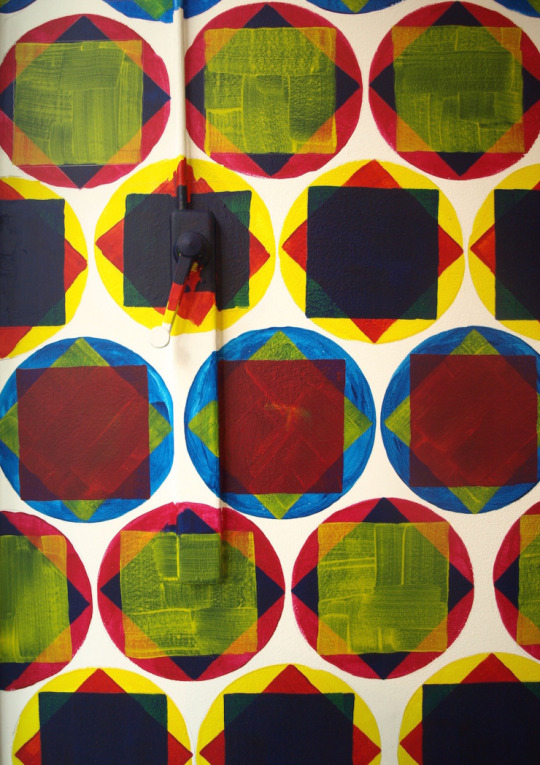
When the Ceiling Meets the Floor, Acrylic paint, 900x450cm approx., The Lab, Dublin, 2015
‘…when an artist sits down to write about another artist, he (she) is also writing about himself (herself).’
– D. Salle, How to See, W. W. Norton & Company Ltd, 2016, p.8.
The area of investigation within my own work explores the ‘extendable paint surface’ and the provisionality this causes within traditional views of painting. Through extensive research followed by the setting of boundaries to work within (for example using only 3 colours, Magenta/Cyan/Lemon, and 3 Shapes, Square/Circle/Triangle) I find possibilities to make painting for now. Consequently, the visual outcomes found in my work are often biomorphic in appearance; playfully teasing some form of beauty out of a self- conscious awareness of the paint and its own material hybridity.
MYC- neon, Something about some thing to do with Paint, Acrylic paint, medium gel, canvas, wooden structure and steel supports, 200x185cm, The Mac, Belfast, 2014, Photo credit: Simon Mills
MYC- neon, Something about some thing to do with Paint, Acrylic paint, medium gel, canvas, wooden structure and steel supports, 200x185cm, The Mac, Belfast, 2014, Photo credit: Simon Mills
What has become increasingly important within the work I make is how to systematically challenge painting without sacrificing the medium of paint. Peeled and removed paint within my paintings thus acts to reveal the canvases innards while concealing it at the same time, inviting the viewer in to examine its fragments (history) and out: to experience its wholeness (now-ness), making it indeed mysterious and curious as an object of painting.
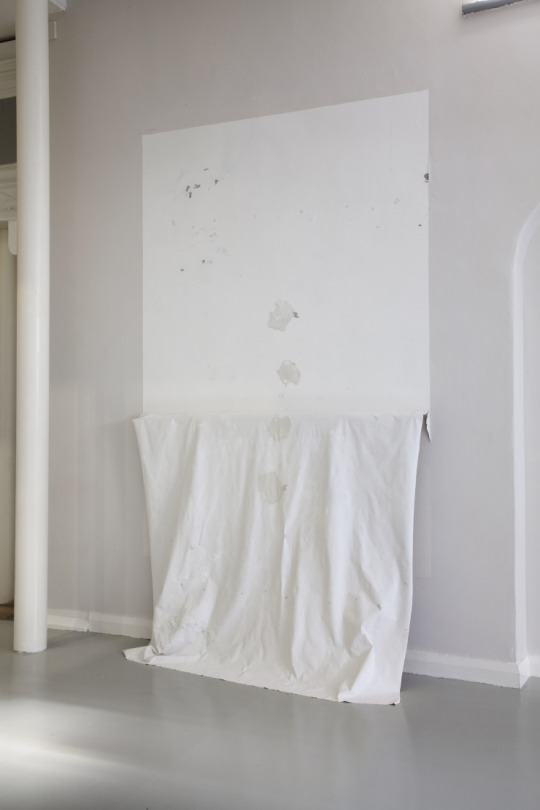
Y_M_C_C_Y_M_M_C_Y_YMCCYMMCY_YMC_CYM_MCY, Acrylic paint, medium gel, wood support, 450x200cm approx., Highlanes Gallery, Drogheda, Photo credit: Davey Moor
Hence it will come as no surprise that what struck me most about my first encounter with the Freud paintings at IMMA was not the normal frontality of his subject matter but rather the way he constructed his paint upon the surface of his supports.

Detail image from Two Irishmen in W11, Oil on canvas, 172.7×141.6cm, 1984-85, Private Collection
Lucian Freud is an artist who has been long celebrated for his painted flesh, but I am not talking about flesh; that meaty and weighty plasma. Rather when confronted with the work in IMMA what I found myself wondering about was the way his paint handling had now become a kind of skin. Skins, which are not of the human variety even though they are suggestive of it, but rather a skin, which has been created touch-by-touch [1], brushstroke by brushstroke, layer over upon layer and within the rectangular confinements of the canvas and beyond.
Freud’s paint surfaces, these skins, are made from and contain huge amounts of paint, paint often arduously yet somehow instinctually applied. The paint skins in each individual painting now hold all manner of evidence such as that of the artist’s hand, his touch, his intensity and importantly his struggle to make an image from this liquid and its fugitivity. Freud’s skins thus make visible not just a specific ‘medium’ (paint), but also content, ideas, and his very process.
Details image from Reflection (Self-Protrait), Oil on canvas, 56.2×51.2cm, 1985, Private Collection
Details image from Reflection (Self-Protrait), Oil on canvas, 56.2×51.2cm, 1985, Private Collection
Upon close-up inspection what becomes noticeable is just how much Freud’s paint skins hold all manner of nuance. They are full of contradictions, somehow appearing both delicate and frenzied within their construction, both abstract and figurative within their picturing. They are beautiful and they make visible so many aspects of Freud’s material inquiry, understanding and long pre-occupation with both colour and medium.
What Freud’s surfaces allow to unfold before the viewer’s eye could be compared to what art historian and theorist Isabelle Graw would refer to as traces of an (his) activity [2]. Freud does this through his very many and varied brushstrokes. Those exquisitely, and more often than not laboured signature marks both embedded within and making visible these very paint skins I find myself gazing upon.
Yet for all of Freud’s frontal seduction and the juiciness of his medium, these paintings are hard won. There are so many paradoxes at play with the evidence of Freud’s own painting battles made visible within the lumpy, scratchy, blobby, melting pigmentation…hands are too big, angles are all wrong, the likeness is clumsy, wonky, weird, compositions are often ever so slightly off and lacking in optical harmony. There is no glamour to his work, only a single-mindedness and he repeatedly makes you aware of this through the dingy and shabby surrounds deliberately left on view of his artist workplace…the studio.
Freud encourages his viewer to enter this world to look beyond his sitters, to peer into and around, to be nosy. His juxtaposition of colours upon each unvarnished canvas draws you inward and invites close up inspection with the image defining the terms of its own making [3] to see how the skin has ‘actually’ arisen. Repetition, and often a lack of sentimentality for his subject matter or site reveal an obsessive tactility. A tactility in the paint handling, in the paint construction, in the many and varied methods of mark making Freud, employed and made visible upon the surfaces of his work. With this tactility in itself also becoming a form of doubling.
Details from Photograph of Freud’s Studio
Details from Photograph of Freud’s Studio
This becomes evident through the expanded nature of his painting beyond the surface of the canvas, beyond and into the world Freud actually inhabited. His daily painting pursuit and importantly his obsessiveness with paint becomes both visual and unmistakable upon the actual ‘Paint-Walls’ [4] he created through years upon years of the smearing of the excess of his paint mixing upon the walls of his studio.
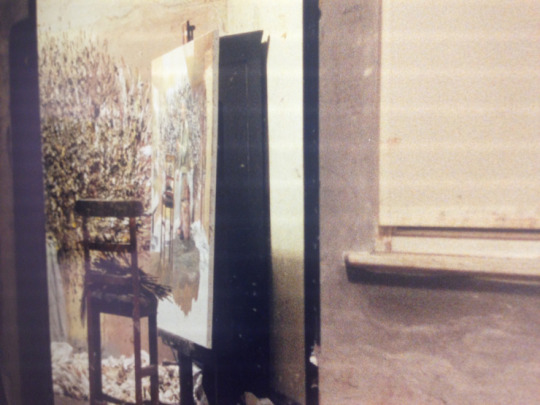
Detail from Photograph of Freud’s Studio
‘Paint-Walls’ now inhabit both the imagined and the embodied world. Eventually, Freud would camouflage his whole existence and being in this second skin. And if you look closely at the paintings themselves in IMMA you can see traces and fragments of the paint-walls/skin growing, you can almost feel it taking over every available surface, breathing and multiplying, sitter after sitter, canvas after canvas. The painterly slowly becomes more about paint and painting, than the images of the flesh.
About the Author
Susan Connolly is an artist based in between Ireland and the UK, she is a graduate of Limerick School of Art and Design, she holds an MFA from the University of Ulster and a first class honours MA from ACW at NCAD, Dublin. Connolly is currently a PhD candidate at Ulster University (2014-2018) where her practice lead research is looking at the slippage and traces within contemporary abstract painting practices.
Connolly has exhibited her work extensively and has work in many private and public collections. She is a Lecturer at WIT and an Associate Lecturer at Ulster University. More information about her work can be found on http://www.susanconnolly.com
Footnotes
[1] R. Shiff, Paint-Wall, in C. Debray, (ed.), Lucian Freud: The Studio, Hirmer Verlag, 2010, p. 64-71.
[2] Isabelle Graw, The Value of Liveliness: Painting as an Index of Agency in the New Economy, Painting beyond Itself: The Medium in the Post-medium Condition, Sternberg Press, 2016, p.79.
[3] Ibid, p. 29.
[4] Ibid, p. 64-71.
Paint Skin? – a blog by Irish Artist Susan Connolly ‘…when an artist sits down to write about another artist, he (she) is also writing about himself (herself).'
0 notes
Text
Gallery Voices: The Underbelly of New York
Gallery Voices: The Underbelly of New York

In our Gallery Voices series Ciara Magee, from our Visitor Engagement Team, explores the subject matter in American photographer Nan Goldin’s exhibition Weekend Plans The exhibition is now in its final week ending this Sunday 15 October. Admission is free. The work of Nan Goldin is a site to behold. Her early work documents New York in the late 1970’s and early 1980’s at a time when artists took…
View On WordPress
0 notes
Audio
https://soundcloud.com/imma-ireland/artists-discussion-hennessy-art-fund-for-imma-collection
0 notes
Text
The Primordial Other; gender and power struggles in the work of Vivienne Dick
The Primordial Other; gender and power struggles in the work of Vivienne Dick

“The web of meaning unravels, and a new one is spun in its place” Homo Deus: A Brief History of Tomorrow -Yuval Noah Harari (more…)
View On WordPress
1 note
·
View note
Audio
https://soundcloud.com/imma-ireland/lecture-claire-pajaczkowska-new-york-no-wave
0 notes
Text
Understanding Hilma - A life dedicated to spirituality in art
Understanding Hilma – A life dedicated to spirituality in art

By Leda Scully ‘But no, she’s abstract, is a bird Of sound in the air of air soaring, And her soul sings unencumbered Because the song’s what makes her sing.’ Fernando Pessoa At the time of her death, the Swedish artist and mystic Hilma af Klint (1862 – 1944) left behind a body of work comprising 1,200 paintings, numerous sketchbooks and 26,000 pages of journals. She stipulated in her will that…
View On WordPress
0 notes
Text
The Relationship between Artist and Model, A blog by renowned American painter Ellen Altfest.
The Relationship between Artist and Model, A blog by renowned American painter Ellen Altfest.

Ellen Altfest in studio. Photograph by Vincent Dillio. Looking at the return to figuration in contemporary art practice, Altfest is one of several artists invited to respond on the affinities, methodologies and potential influences that contemporary artists continue to share with Freud. In conjunction with Altfest’s memorable Artist’s Talk at IMMA in June, we invite the artist to write a blog on…
View On WordPress
2 notes
·
View notes
Text
I was invited by IMMA to respond to their exhibition, As Above, So Below: Portals, Visions, Spirits & Mystics, and to work with Alice Butler and Daniel Fitzpatrick of AEMI to develop a screening for the IFI in conjunction with IMMA’s Talks and Public Programmes. The resulting programme – Out of Body – features films by Maya Deren, Mairéad McClean, Jordan Baseman, Paul Sharits, and John Smith, alongside a selection of my own work. These films consider the psychic and physical spaces of body and landscape; they explore automatic, subliminal and unconscious states of mind. Multiple viewpoints, strobing, and repetition draw attention to our perceptual senses, and to the very act of looking, and of being observed. Out of Body took place at the IFI on Tuesday 25 July 2017 and you can listen back to the introduction and discussion here.
I was commissioned to write a text to capture this curatorial process, my thinking behind the selection and my relationship with IMMA.
Medium Stanislava P, 13 June 1913
From Phenomena of Materialisation, A Contribution To The Investigation of Mediumistic Telepastics, Baron von von Schrenck Notzing, 1923
The end is the beginning is
Three years before the turn of the 21st century, and sparked by a television documentary, I became captivated by the activities of the séance room, ideas about the psychic medium as producer of image (ectoplasmic emanations etc.) and the role of the camera within the séance room as observer and document maker. The collision of the birth of modern spiritualism (1848) and the popularisation of photography fascinates me. It’s now twenty years since I first picked up a video camera and began using the fields of psychical research and the narratives of the paranormal, as my subject matter. My films have investigated materialisation mediums, ectoplasm, trance, hysteria, table tilting, clairvoyance and telepathy.
While I frequently present experimental and artist film to my students, this invitation has afforded the opportunity to screen films within a cinema setting and to work with AEMI and IFI to access work in a range of formats. I knew early on that I wanted to include Maya Deren’s Witch’s Cradle and John Smith’s Om, and these works became a starting point for our conversations.
Psychic Edit, 2008, Susan MacWilliam
Courtesy of Susan MacWilliam and CONNERSMITH
We discussed which of my films to include and agreed firstly on Psychic Edit. Out of Body commences with this 14 second looping film as the audience enters the auditorium. The subject of Psychic Edit is the Irish medium Eileen J. Garrett. It features family movie footage and an image of Garrett’s smile. Garrett is said to have possessed a charisma that would warm any room she entered. Psychic Edit sets out to lodge images of this magnetic personality in the viewer’s mind. My friendship with Eileen Garrett’s family has opened many doors for me, and she has become the ‘glue’ that connects much of my work.
Webs, strings and interconnectedness
I first encountered Maya Deren’s films in 1999 when living in New York during my residency at PS1 Center for Contemporary Art. At the time, having seen very little artist film I was working within a limited context of knowledge. In New York I saw Nam June Paik’s retrospective at the Guggenheim, Martha Rosler’s solo show at the New Museum, and film and video programmes, curated by Chrissie Iles at the Whitney, that included Maya Deren, Yvonne Rainer, Gary Hill, and Bruce Nauman. Deren’s interest in consciousness and altered states resonated with me.
Left: Witch’s Cradle, 1943, Maya Deren. Courtesy of LUX, London | Right: The Last Person, 1998, Susan MacWilliam. Courtesy of Susan MacWilliam and CONNERSMITH
Shot in Peggy Guggenheim‘s The Art of This Century gallery, Deren’s Witch’s Cradle features as the central protagonist a woman, Ann Matta Clark, and a male figure, Marcel Duchamp. The landscape they occupy is littered with objects, sculptures and string. The female figure moves through the space as if trying to make sense of, or control the strange forms. Objects move as if by their own accord, by magic or via unseen forces; a string moves up Duchamp’s leg and across the nape of his neck. The words ‘the end is the beginning is’ encircle a pentagram marked on the woman’s forehead. I see strong visual parallels between Deren’s film and my film, The Last Person, which depicts the phenomena of the séance room.
Higher Beings Command, 1968, Sigmar Polke
Harvard Art Museums/Busch-Reisinger Museum (C) Estate of Sigmar Polke / Artists Rights Society (ARS), New York / VG Bild-Kunst, Bonn, Germany. http://www.harvardartmuseums.org/collections/object/348394
Higher Beings Command
Sigmar Polke’s Higher Beings Command, a series of 14 lithographs exhibited in As Above, So Below, depicts both Polke and various inanimate objects taking on the form of other things. I find them peculiar and intriguing in a similar way I do the spirit photographs I’ve worked with in my own research. Higher Beings Command, Witch’s Cradle and The Last Person share sculptural and performative connections.
Psychic and psychedelic
Eileen Garrett is often referred to as the world’s most famous psychic medium. She was deeply inquisitive and supported many in the fields of parapsychology, literature and the arts. She was supportive of Maya Deren and her interests in the spiritual and the occult. Deren’s essay, Religion and Magic, is published in Garrett’s Tomorrow magazine (Haiti issue, Autumn 1954). Aldous Huxley was amongst Garrett’s eclectic circle of friends, and with him she experimented with LSD to see if it might enhance her psychic abilities.
Following our initial conversation Alice, Daniel and myself corresponded via email. I proposed a number of works and Daniel suggested Paul Sharits’ Ray Gun Virus. Alice and Daniel worked on the running order, and Alice was instrumental in the logistics of accessing screening copies from LUX, London.
Ray Gun Virus, 1966, Paul Sharits.
Courtesy of LUX, London
Ray Gun Virus is a structural flicker film. MOMA, said of it, “…with films like RGV, LSD may become obsolete.” In the 1950s at one of Eileen Garrett’s Parapsychology Foundation conferences, the psychiatrist Humphrey Osmond drew comparison between mediumistic experiences and those of patients under the influence of LSD. In the early 1960s, Brion Gysin, with Ian Sommerville, built the Dreamachine, a rotating cylinder with cut outs and a light bulb inside. Placed on a turntable and spinning at 78rpm it is viewed with the eyes closed. The light flickers at a similar frequency to Alpha brain waves. Gysin was fascinated in consciousness and perception and Eileen Garrett was said to have been of great influence upon him.
https://en.wikipedia.org/wiki/Structural_film
https://en.wikipedia.org/wiki/Dreamachine
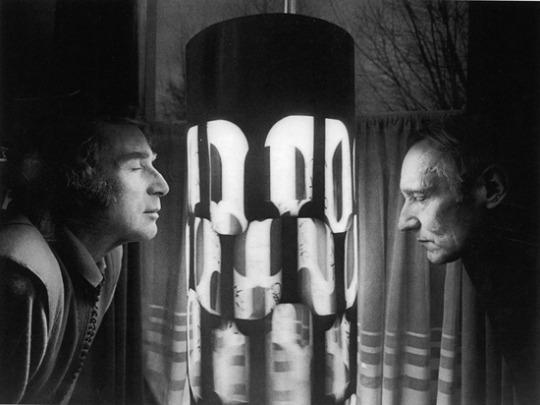
Brion Gysin and William Burroughs with the Dreamachine.
Photograph by Charles Gatewood
Faint, 1999, Susan MacWilliam
Courtesy of Susan MacWilliam and CONNERSMITH
Out of body
My first connection with IMMA was when I was there as artist in residence in 1998. Shot in the grounds and interiors of IMMA, Faint, explores ideas about trance, mesmerism and hysteria. When Faint was exhibited recently at the Swedenborg Film Festival, London, I had the sensation while watching it, that the girl in the film (myself 19 years earlier) could be my niece, and myself her aunt. This feeling of familiarity yet disconnect gave me a peculiar feeling of being ‘out of body’. Faint shares with Mairéad McClean’s State of Mind remix #4 the image of a female figure in the landscape. State of Mind explores whether experiences carried in our memory can come back to haunt us. A sense of anxiety is conjured through its use of imagery and sound.
State of Mind remix #4, 2005, Mairéad McClean
Courtesy of Mairead McClean
Water, mist, smoke and ectoplasm
Landscape is concealed and revealed in Mountain Mist. The steam is echoed by the ectoplasm in The Last Person, by the wisps of smoke in Om, and the billowing smoke in State of Mind. Jordan Baseman’s intensely silent and intensely visual The Black Sea is visceral and bodily; it feels like a breathing organ. Baseman processes his 16mm film in buckets; the images of the sea materialising with the ebb and flow of the chemicals. The material physicality of this low-tech process is worn into the surface of the film. Baseman uses a fixed camera position as does Steve McQueen, whose Running Thunder, is presented at IMMA. In Running Thunder the dead horse no longer breathes, while the grass around it moves gently in the air.
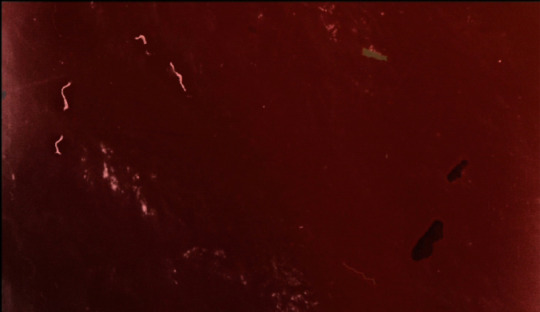
The Black Sea, Jordan Baseman, 2010/2013, UK|USA, 3 minutes. Courtesy of Jordan Baseman and Matt’s Gallery.
John Smith’s Om brings to mind the saturated photographs of Kenneth Anger at IMMA. Om plays with our sense of perception. It forces us to think about how we read an image, how we consider belief systems, and how we make judgments. Like magic, can we really trust our eyes and ears?
Left: Om, 1986, John Smith. Courtesy of John Smith and LUX, London | Right: Lileth (Marianne Faithful), 1970-71, C-Print Kenneth Anger. © Kenneth Anger
Courtesy of the artist and Sprüth Magers
The end is the beginning is
The screening ends with The Last Person. For me this is where it all began. Made in 1998, this was my first film. It features me reconstructing the phenomena of the séance room and acting as the medium Helen Duncan, who in 1944 was the last person imprisoned under the British Witchcraft Act of 1735. In 1998 it screened in First Cut, at the IFI (IFC), and the following year was nominated for the IMMA Glen Dimplex Artists Award. The circle has turned a full revolution as The Last Person returns to the IFI through an invitation from IMMA.
Left: The Last Person, 1998, Susan MacWilliam. Courtesy of Susan MacWilliam | Right: Witch’s Cradle, 1943, Maya Deren. Courtesy of LUX, London
Out of Body – List of Films
Psychic Edit, Susan MacWilliam, 2008, Ireland, DCP, 14 seconds looped
Learn More on susanmacwilliam.com
Witch’s Cradle Outtakes, Maya Deren, 1943, U.S.A., Digibeta, 10 minutes
Learn more on lux.org.uk
State of Mind remix #4, Mairéad McClean, 2005, Ireland, DVD, 10 minutes
Learn more on maireadmcclean.com
Faint, Susan MacWilliam, 1999, Ireland, DCP, 4 minutes
Learn more on susanmacwilliam.com
The Black Sea, Jordan Baseman, 2010, U.K-U.S.A., Blu-ray, 3 minutes
Learn more on jordanbaseman.co.uk
Mountain Mist, Susan MacWilliam, 2002, Ireland, DCP, 8 minutes
Learn more on susanmacwilliam.com
Ray Gun Virus, Paul Sharits, 1966, U.S.A., 16mm, 14 minutes
Learn more on lux.org.uk
Om, John Smith, 1988, U.K., 16mm, 4 minutes
Learn more on johnsmithfilms.com
The Last Person, Susan MacWilliam, 1998, Ireland, DCP, 11 minutes
Learn more on susanmacwilliam.com
With thanks to the artists and LUX for providing copies of the films.
Further Information
Upcoming IMMA & AEMI, IFI Programme
IMMA is delighted to continue its collaboration with Aemi Projections, when invited artist Vivienne Dick curates a screening programme to coincide with her show at IMMA. This takes place at the IFI on Tuesday 10 October 2017 more details are available here.
About the Artist
Susan MacWilliam’s touring solo survey exhibition Modern Experiments, which features her films, video installations and sculptures will run at Uillin: West Cork Arts Centre, Skibbereen from 9th September – 18th October, and at Butler Gallery, Kilkenny from 28th October – 17th December 2017.
Susan MacWilliam. Born in Belfast and currently based between Belfast and Dublin, where she teaches at the National College of Art and Design, Susan MacWilliam has exhibited nationally and internationally with solo shows in New York, Dublin, London, VictoriaB.C. Northampton and Derby. MacWilliam has worked with prominent parapsychologists and psychical research institutions, including poltergeist investigator William G. Roll, the New York family of Irish born medium Eileen Garrett and the Dermo Optical Perception Laboratory of Madame Yvonne Duplessis, Paris. She has worked extensively with historical archives including those of the Parapsychology Foundation, New York; Hamilton Family fonds (spirit photograph archive), University of Manitoba; Parapsychology Laboratory Records, Duke University; and Rhine Research Center, Durham, NC. Learn more about Susan MacWilliam on her website.
OUT OF BODY – SUSAN MACWILLIAM I was invited by IMMA to respond to their exhibition, As Above, So Below: Portals, Visions, Spirits & Mystics…
0 notes
Audio
https://soundcloud.com/imma-ireland/imma-aemi-projections-ifi-out-of-body-susan-macwilliam
0 notes
Audio
https://soundcloud.com/imma-ireland/as-above-so-below-artists-talk-stephan-doitschinoff
1 note
·
View note
Text
Calling Participants! CVLTO DO FVTVRV comes to IMMA as part of 'Wilder Beings Command!'
Calling Participants! CVLTO DO FVTVRV comes to IMMA as part of ‘Wilder Beings Command!’

Artist Stephan Doitschinoff, currently exhibiting at IMMA as part of As Above, So Below: Portals, Visions, Spirits & Mystics, will return to IMMA this July to present the CVLTO DO FVTVRV procession, a parade conceived in partnership with philosophical society CVLTO DO FVTVRV. The parade will be part of an exciting outdoor evening of performances at IMMA titled Wilder Beings Command! (more…)
View On WordPress
0 notes